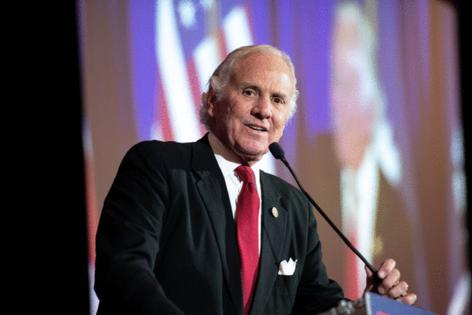Henry McMaster wanted to save James Brown's charity. Instead he upended it
Published in Entertainment News
COLUMBIA, S.C. — By his own account, South Carolina Gov. Henry McMaster is a big fan of James Brown.
And it wasn’t just Brown’s music. When the singer died on Christmas Day 2006, he left the majority of his estate to fund a charitable trust that would provide educational scholarships for the children of South Carolina and Georgia.
From the start, Brown’s estate was bogged down in legal infighting. But few events were more significant or more controversial than a 2008 settlement brokered by the South Carolina Attorney General’s Office under McMaster.
Years later, the state Supreme Court called his solution a “total dismemberment” of Brown’s estate.
The settlement they reached gave more than half of Brown’s estate away to people he had largely excluded from his will: his children and the woman thought to be Brown’s last wife, Tomi Rae Hynie.
This fateful decision kicked off an escalating legal battle that continues and is, according to some, holding up Brown’s charity to this day.
McMaster declined to comment for this story. But in 2016, he made his views clear.
“I thought it was it was a good settlement, and I think it was a better settlement than is going to eventually come out of the matter,” testified McMaster in a deposition. “If I could snap my fingers and make everything perfect I certainly would.”
What happened?
A year after Brown’s death, his estate had been consumed by legal infighting.
One of the estate’s original personal representatives, Brown’s longtime accountant David Cannon, was found to have stolen millions from Brown over several years. Cannon was indicted, and the other two personal representatives resigned.
The new court-appointed personal representatives, lawyers Adele Pope and Bob Buchanan, were clashing with Brown’s family.
Brown’s children, represented by attorney Louis Levenson, and attorneys for the woman believed to be Brown’s last wife, worked together to try to have Brown’s will thrown out.
Brown’s will had left almost his entire estate to fund the “I Feel Good” Trust. To his six recognized children, he left his household possessions and the value of insurance policies. To Hynie, whose marriage to Brown was legally in doubt after it was revealed she was still married when she wed Brown, he left nothing. His son with Hynie was also excluded
Amidst this chaos in September 2007, the South Carolina Attorney General’s Office began to take a serious interest in the case. An assistant attorney general named Sonny Jones in the office’s civil division led the charge.
The case was “hotly contested,” Jones recalled in a 2016 deposition. Everybody had a different opinion and “there was a lot of finger-pointing.” A number of people had contacted the office about getting involved, including a prominent Columbia attorney, I.S. Leevy Johnson, and even David Cannon, who Jones recalled showed up out of the blue at the attorney general’s office.
In September, the attorney general’s office filed a notice to intervene in the case in order to protect the future recipients of Brown’s charity.
One of Hynie’s attorneys, Alan Medlin, and Jones were “close, personal friends,” Levenson said later in a deposition. For Levenson’s part, he and Jones grew close and went to baseball games together.
That December, Hynie and Brown’s children filed their official challenges to Brown’s will, citing “undue influence” from the original personal representatives.
But Pope and Buchanan’s dogged defense of Brown’s will began to drive a wedge between the two groups. Things only grew worse in 2008. The low point came following a sale of some of Brown’s possessions at the Christie’s auction house in New York.
As the situation began to look untenable, the attorney general’s office swooped in to help make a deal. As attorney general, McMaster had the legal authority to protect the future recipients of the charitable trust.
“The establishment of a trust for the poor schoolchildren in Georgia and South Carolina is a very good purpose, and we had the duty and perhaps opportunity to see that it was fulfilled,” McMaster said in a deposition in 2016.
On Aug. 8, 2008, representatives from the office met with representatives from the children and Hynie’s camp. The location of their meeting was the Marriott Hotel in Augusta, Georgia, which overlooks James Brown Boulevard. Pope and Buchanan were not present.
Despite their closeness, Levenson maintained that they were “adversaries” with Jones during negotiations.
But Brown’s children and Hynie could hardly have asked for a better deal. The settlement, announced on Aug. 10, 2008, gave roughly a quarter of Brown’s estate to Hynie and another quarter to his children.
Hynie would also be officially recognized as Brown’s wife. The “I Feel Good” Trust would be dissolved. What remained of the estate, slightly less than half of the total assets, would go to a new trust set up and controlled by the South Carolina Attorney General’s Office.
Why would McMaster’s office agree to the deal? If the lawsuits file by Hynie and Brown’s children were successful and Brown’s will was thrown out, Georgia and South Carolina children may have gotten none of the estate. Under the deal, the schoolchildren would have gotten half of it.
McMaster defended the deal to the New York Times. “We arranged for the charity to get almost half of it. Half of something big is better than nothing.”
The deal also called for Pope and Buchanan to be removed as personal representatives. But the pair refused to go quietly. In 2009, they filed a legal challenge to the Attorney General’s settlement accusing it of dismembering Brown’s estate in violation of his wishes.
That decision changed everything.
The Supreme Court weighs in
After three years of appeals, the South Carolina Supreme Court finally weighed in on McMaster’s plan.
By this point, things had only gotten more convoluted. McMaster was out of office, having launched an unsuccessful run for governor. But his successor, Attorney General Alan Wilson, had taken up the defense of the settlement. Bob Buchanan had accepted a $500,000 settlement and exited the case. Adele Pope was being sued for her opposition to the settlement and was suing the attorney general’s office in return over its refusal to disclose documents.
In this chaos, the Supreme Court’s ruling landed like a bomb. The justices unanimously overturned the attorney general’s settlement.
The settlement amounted to “the total dismemberment of Brown’s carefully crafted estate plan and its resurrection in a form that grossly distorts his intent,” the justices wrote.
In the justices’ words, the attorney general’s office had made an “outright gift” of half of Brown’s estate to people who were specifically excluded from his will based on “tenuous claims.” The office had also dissolved Brown’s irrevocable trust and transferred what remained of the estate to a trust under the attorney general’s sole control.
It was an “unprecedented misdirection” of the office’s powers in estate cases, the justices wrote.
The claim that the settlement would benefit recipients of scholarships by avoiding further litigation was “illusory at best.”
The court upheld Pope and Buchanan’s removal as personal representatives, citing the “dischord” between the parties. Many were optimistic that the ruling would allow for a fresh start.
But that’s not what happened. Since the settlement was overturned, Brown’s estate has been bogged down in more than a decade of legal infighting. Lawyers for the estate’s current personal representative have said that they do not consider the Supreme Court’s ruling “a victory.”
Meanwhile, Pope has continued to fight legal battles that stem from her opposition to the settlement. Seventeen years since that fateful day on James Brown Boulevard, the attorney general’s settlement has cast a long shadow over James Brown’s estate.
©2025 The State. Visit thestate.com. Distributed by Tribune Content Agency, LLC.
















Comments